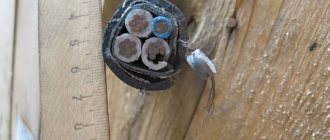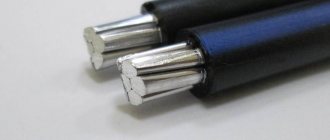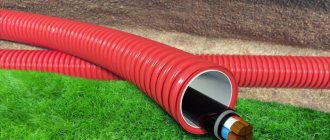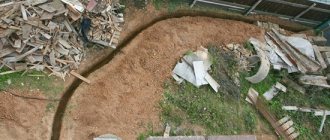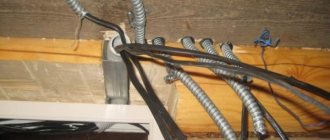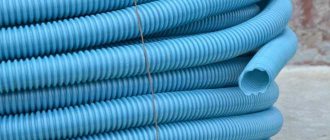Requirements for cables laid underground
Listing all the requirements for underground electrical wiring is long and simply pointless. Therefore, most of them will be considered next, which really concerns the laying of power cables in trenches.
- The depth at which the cable must run underground. If someone thinks that they can simply sprinkle the electrical wire with earth and this will be enough to prevent it from being damaged by a shovel during any excavation work, then this is not so. In reality, the depth to which the wire should be immersed in the ground depends on the freezing of the soil and the proximity of groundwater, which often causes irreparable damage to the power lines in the trench. The PUE clearly states that the cable must be buried at least 75 cm in the ground, but it is important to take into account that this applies to low-power power systems.
- High protection of underground electrical wiring from mechanical damage. To do this, the cable is inserted into a special pipe or corrugated hose. You should not think that this is reinsurance; such safety measures allow you to avoid damage to wires by ice in the winter season and when the ground moves. In addition, according to experts, a cable laid in a pipe is easier to replace if the latter fails. But in this situation, it all depends on how long the power system lay underground, since very often the pipe can collapse over time.
- Adding sand to the trench is also a fairly important factor, providing additional protection for underground cables from mechanical damage. Thanks to the sand cushion, the wire will not come into contact with solid soil particles. In this case, the backfill is carried out in several stages: to the bottom of the trench and on top of the laid wires. Thus, the electric cable turns out to be between two sand layers. It is very important that the bedding, like the backfill, is compacted well.
- Installation of a signal tape, which acts as a kind of beacon warning that there are electrical cables underground. The tape is laid over the cable in the trench at a distance of approximately 25 cm above the power network. This is due to the fact that the bayonet of the shovel will not reach such a depth. In the case of high-voltage underground electrical wiring, bricks or concrete slabs laid on top of the wires are used as a beacon.
It is important that underground cables are not too stretched - do not skimp on wire footage. This is necessary so that when the ground moves, the electrical network does not break. According to the technology of underground cable laying, it is provided to leave a reserve, which is achieved by laying cables in small waves.
This concerns the most significant requirements in accordance with which electrical lines are laid underground. In addition to the above-mentioned PUE standards, there are also other requirements that can be found very often.
- Laying wires under roads - they must be made in a thick-walled metal pipe. This is due to increased pressure on the ground from cars and trucks passing along the road, which can cause soil movement. And, as you know, this can lead to breakage of electrical wires.
- Cables laid parallel to each other. In such a situation, everything will depend on the power characteristics of the electrical network. But in general, it is important to realize that several wires cannot be inserted into one pipe, since if one cable breaks down, the adjacent wire may also be damaged. According to the standards, each wire must be placed in an armored sleeve and located no closer than 15 cm from the adjacent cable.
Also, backfilling of cables in the ground cannot be carried out without inspection. It is imperative to ensure the integrity of the wiring and only then finally fill the trench with earth. In this case, a visual inspection is not enough; it is better to ring the wires using instruments. In addition, the protection of underground electrical wiring plays an important role, which will be discussed in more detail.
Communication cable at what depth. Communication cable laying standards
3. Basic operational and technical requirements for linear structures of local communication networks 3.1. General requirements 3.2. Requirements for cable lines, cable entries and cable terminal devices 3.2.1. Requirements for cable lines laid directly in the ground
3.2.2. Requirements for cable lines laid in sewers 3.2.3. Requirements for cable lines laid along the walls of buildings 3.2.4. Requirements for cable lines suspended on supports and racks 3.2.5. Requirements for wired cable lines 3.2.6. Requirements for equipment for cable entries into buildings 3.2.7. Requirements for cable terminal devices 3.2.8. Requirements for cable lines laid in collectors and tunnels. 3.2.9. Requirements for cables laid over bridges. 3.2.10. Requirements for cable ducting 3.3. Requirements for overhead pole lines 3.4. Requirements for overhead rack lines 3.5. Requirements for the protection of linear structures of local communication networks from hazardous voltages and currents
Rules for maintenance and repair of communication cables
3.2. Requirements for cable lines, cable entries and cable termination devices
3.2.1. Requirements for cable lines laid directly in the ground
3.2.1.1.
For laying directly in the ground, cables with armor made of steel tapes should be used. It is allowed to lay unarmored cables of the KSPP and PRPPM brands directly in the ground. 3.2.1.2. The underground cable route must be leveled and free of dips, ridges and holes in the locations of couplings (splices). The cable line route outside populated areas should, as a rule, run along highways.
3.2.1.3. The cable should be laid in the middle of the trench bottom without tension, with slack and tightly adjacent to the trench bottom. When laying several cables in one trench, they should be placed in parallel without crossing, with a distance between them of at least 50 mm. In this case, the couplings in the pit should be placed offset or staggered.
3.2.1.4. The depth of laying cables (armored and unarmored) directly in the ground on local communication networks should be taken as follows:
a) in soils of groups I - IV:
1.2 m - for optical cables on inter-office trunk lines;
0.8 m - for electrical cables on local (urban and rural) networks outside populated areas and 0.7 m - in populated areas. If it is necessary to lay cables at a depth less than specified, protection of the cables from mechanical damage must be provided in the form of laying bricks (concrete slabs) over the cable on top of a layer of soft earth or sandy soil 0.1 m thick;
b) in soils of group V and above, as well as in soils of group IV, developed by explosive methods or jackhammers:
when rock reaches the surface - 0.4 m for all types of cables (trench depth - 0.5 m);
if there is a surface soil layer above the rock - 0.6 m for all cables (trench depth 0.7 m). In this case, the penetration into solid rock (rock) should be no more than 0.5 m. With a soil layer with a thickness of 0.7 to 1.3 m, the cable should be laid above the rock at a distance of 0.1 m.
The methods and depth of laying unarmored cables in plastic sheaths directly into the ground, as well as in metal sheaths with plastic protective hoses with an outer diameter of less than 20 mm in areas infested with rodents, must be adopted in accordance with the instructions of VSN 116-93 of the Russian Ministry of Communications.
Did you like the video? Subscribe to our channel!
There are strictly standardized requirements for laying coaxial telephone cables in the ground, which were established more than 15 years ago by the Ministry of Communications (such rules were also declared in the PUE document). The most important thing is to provide reliable protection from mechanical stress and soil compression.
Laying a telephone communication cable in the ground requires the use of a special type of TB cable, TPPepB. It is armored, multi-core with a reinforcing layer, which provides static discharge, as well as protection from external magnetic influence (electromagnetic waves).
Laying is carried out in a trench, the depth of which cannot be less than 70 centimeters. If laying through a parking lot, road, residential area, then the depth increases to 1.15 meters. A project plan for laying a telephone communication cable is prepared in advance. It cannot be closer than 1 meter to electrical communications. The situation is the same for sewerage.
A sand cushion is placed in the trench in a layer of 10-20 centimeters. It prevents the cable from being compressed by the soil, as well as roots from growing through this area. The cable is laid without bends, without additional fastenings. The trench is filled from above with a mixture of earth and sand. A telephone cable must be marked along its entire length either with a signal tape or with special signal posts on which the technical characteristics of the cable are recorded, as well as the station to which it belongs.
At the same time, communication cables for laying in the ground (TPPepB) have an armored structure. There are different types, depending on the number of cores inside. At the moment, the 12-wire cable is most often used, through which it is also possible to transmit an Internet signal. The cores, by the way, are inside the cable - they are parried. These are features of the technical structure, and not additional protection against rupture.
For TPPB type cables, the ambient temperature should not fall below -20 degrees Celsius. For TPB type cables, the temperature should not be lower than -10 degrees. Otherwise, the core can very easily be damaged at the slightest load. For example, high voltage is not transmitted through a telephone cable, so the cable does not warm up.
In the same case, if the laying of a telephone communication cable in the ground is carried out where the temperature can drop even lower, then either special types of cables are used, or a closed-type heating cable is laid next to it. But in Russia there are no such places, not even in Siberia.
And the latest thing is that a control unit is installed every 10 kilometers of telephone cable. It is used to check the cable break, its resistance, and the final voltage. In the event of a breakdown or cable break, with the help of such blocks you can quickly locate the “problem” location. True, such units are not installed everywhere in Russia.
Requirements for laying communication cables depend on several criteria, which include, among other things: the installation method (in the ground or in the air), climatic conditions in the region, the type and characteristics of the cable products used.
Rules and regulations for laying communication cables in the ground
It is allowed to lay in the ground by trenching (the trench is dug before laying) and trenchless methods (using cable-laying equipment). In soils of categories I, II and III (unless the standard design for laying communication cables provides otherwise), trenchless installation is always used. The same applies to category IV soils, provided that soil digging is carried out 2-3 times. If the use of cable-laying mechanization equipment in the area is complicated (for example, rocky terrain), the use of drilling and blasting equipment is permissible.
1.2. Laying depth
The rules for laying communication cables (optical and electrical, armored and unarmored) provide for the following values of installation depth in soils of categories I-IV:
1.2 m for trunk, trunk connecting and optical intrazonal cable communication lines (MKLS/MSKLS/VZKLS, respectively). . 0.9 m - electrical cables of VZKLS lines for wire broadcasting class I. . 0.8 m - electrical cables of primary networks outside populated areas (0.7 m when laid in populated areas), as well as class II wire broadcast lines.
The standards for laying communication cables in soils of category V and higher determine the following values of masonry depth (the requirements are also valid for soils of category IV developed by drilling and blasting equipment):
0.5 m - for all types of cables, provided that rock reaches the surface to a height of up to 0.4 m. 0.7 m - all types of cables in the presence of a soil layer over rock up to 0.6 m thick. In this case, the communication cable is buried in the rock to a depth of 0.5 m. If the thickness of the soil layer is more than 0.7 m and less than 1 .3 m, the cable is not buried in the rock, but is laid above it at a distance of 0.1 m.
The depth of laying cable lines in permafrost soils and soils with deep freezing is carried out in accordance with the requirements of SNiP for laying communication cables, design and construction of foundations for buildings and structures in permafrost areas (SNiP II-15-74 and SNiP II-18-76).
Laying a communication cable (PUE 2.3.83) in a pre-developed trench involves the construction of a cushion in its lower part and an upper covering layer of sandy soil 10 cm thick. According to clause 2.3.86 of the PUE, joint laying of communication and power cables is permissible in one trench when maintaining a distance of 500 mm between them. Cables of wired broadcasting lines can also be laid together, provided that they have the same performance class (the distance between them is also 500 mm). At the same time, it is not recommended to lay more than 6 cables in one trench (unless the standard design for laying communication cables does not contain special requirements with justifications for the decisions made).
When crossing cable lines with railway tracks or highways, the communication cable is laid in pipes with a diameter of 100 mm, made of polyethylene or asbestos cement. The same requirement is valid for laying single-pair cables for service stations and wired broadcast networks.
When constructing trenches in soils with high water levels and when laying pipes above the depth of seasonal soil freezing, additional measures must be taken to protect cables, given in the “Instructions for protecting communication cables from being crushed by ice in a flooded cable duct of the Russian Ministry of Communications.”
The laying of cable lines through areas with stray currents (for example, electrified tram tracks) is carried out in accordance with the current GOST for laying communication cables (GOST 67-78).
Norms and rules for laying communication cables in cable ducts and manifolds
The rules for laying cables in sewers are different for different types of cables. are laid, as a rule, in free channels in the amount of 5-6 units. If electrical cables are already laid in the channel, the “optics” are laid in a polyethylene pipe (or without it if the cable is armored with an additional protective sheath).
Requirements for laying certain types of subscriber communication cables in sewers:
KM-4, KMA-4: laying only in a free channel. Cables with an outer diameter of 40 mm are laid in the lower rows of the sewer system. The requirements for location in the channel also apply to cables of types TP, TZ and T3A. . MKT-4, MKTA-4, VKPA-10: installation of up to 3 units in one channel is possible. . MKS, : laying of these types of cables in one channel is unacceptable (except for individual cases and subject to joint laying for no more than 1 km).
Joint installation of communication cables and wired broadcast cable lines in a single sewerage block is permitted under the following conditions:
The rated voltage does not exceed 240 V along the entire length of the cable line; . the length of the parallel cable laying section does not exceed 2 km (cable and) and 3 km (, RMZEPB); . absence of communication cables used in frequency division data transmission systems (FDM) in a single channel; . all cables must have a protective screen grounded at both ends to a grounding device with resistance in accordance with GOST 464-79.
Rules and regulations for laying communication cables in collectors:
With a single-row arrangement of cables: cables are laid on top, wired broadcast cables are laid below, other communication cables are laid even lower, and heating and water supply lines are located below them. . In a double-row arrangement, it is permissible to lay cables on both sides of the aisle. In this case, on one side, the cables are arranged in the following order (from top to bottom): wired broadcasting, electrical wiring, communications and heat-conducting channels underneath them. On the other side (top to bottom): power cables, wired broadcasting, communication cables, plumbing. . Communication cables should be removed from power cables at a distance of 20 cm, from heating and water supply systems - at a distance of 10 cm.
Suspension of cables on overhead line supports
Hanging of communication cables is usually carried out during the construction of telephone distribution lines of the urban telephone system, inter-exchange lines of the telephone network and intra-zonal networks, where another method of installation is difficult. In this case, the cables are suspended on existing overhead lines (the cable capacity should not exceed 100 pairs) below the existing power lines. It is permissible to hang GTS and STS cables with a capacity of no more than 30 pairs in populated areas on rack supports installed on the roofs of buildings.
Suspended structures require the use of special brands of cables equipped with a steel support cable - , VKPAPut, VKPAPt, and others. The cable is grounded at both ends and additionally every 250 m in populated areas and 2-3 km in all other areas.
Requirements for laying communication cables across water barriers
Laying cable lines across water barriers (rivers, lakes, etc.) is carried out depending on local conditions by laying the cable under water, over a bridge or over overhead lines.
When laying cables of primary networks with a capacity of up to 100 pairs over a bridge across non-raftable and non-navigable rivers up to 100 m wide, it is permissible to use suspended structures. The main lines are laid along two sections at a distance of 300 m from each other. A number of other structures can be used for laying across the bridge in accordance with SNiP 2.05.03-84. This method also involves the use of cables with a plastic, steel or aluminum (plastic-coated) sheath. Laying lead-sheathed cables over bridges is prohibited.
When laying underwater from railway and road bridges, the cables are located at the following distance:
1000 m (bridges of main roads) and 200 m (bridges of regional and local significance) when laying cables across inland waterways, water canals, navigable rivers, and reservoirs. . 300 m - laying through rafting rivers. . 50-100 m - non-raftable and non-navigable rivers.
Cables are laid buried in the bottom of the reservoir, regardless of the depth of navigable and raftable rivers, as well as non-navigable and non-raftable rivers with a depth of more than 3 m. Laying without burial along the bottom of reservoirs and lakes is permissible.
The depth of cable penetration, depending on the nature and depth of water obstacles, can be
b:
1 m - when laying through water obstacles with a stable bed (0.5 m with a changing bed); . 1 m - through drainage channels (with protection from mechanical damage by reinforced concrete slabs) and 2 m (without protection). . 1.2 m - reservoirs up to 6 m deep and 300 m wide, with a current speed of about 1.5 m/s. The laying will be carried out using a trenchless method with 2-3 times puncturing the bottom.
Depending on the specific situation, the communication cable can be laid in plastic or metal pipes along the entire length of the underwater route (in coastal areas the use of pipes is mandatory).
is one of the leaders in the sale of cable products and has warehouses located in almost all regions of the Russian Federation. By consulting with the company’s specialists, you can purchase the brand you need at competitive prices.
Requirements for PUE protection
Protection of electrical lines is considered the most important condition for laying wires in a trench underground. At the same time, according to the PUE, a whole list of requirements is imposed on underground electrical wiring.
- At the point where the electric line enters the house, the cable is placed in an asbestos-cement coupling, which protrudes at least 60 cm on each side of the wall.
- Throughout the entire duration of underground electrical wiring, the cables are protected by bricks laid across the wires or an asbestos-cement pipe. This is necessary to protect the electrical network from soil subsidence.
- When laying several wires in one trench, the distance between adjacent cables should not be less than 10 cm for a 10 kV network, 25 cm if it is a 20-35 kV high-voltage network and 50 cm between wires of different organizations.
- Wires laid in a trench must be covered with a layer of soil and laid with mechanical protection or warning tape.
- The signal tape must not be laid directly on the cable. From the wire to the beacon there must be at least 25 cm vertically. If several wires are laid in a trench, the tapes are laid separately above each cable.
- If the cable line crosses other communication systems, the warning tape should be laid no closer than 200 cm from adjacent communications.
We are developing the route
The route for underground cable laying from the pole to the house will be drawn for you in the project and all that remains for you is to follow all the instructions. But when distributing electricity along the site, you have to design the route yourself. The most economical option is a straight line from one point to another. But a real route like this practically never happens. Most often this is a broken line, since you have to go around many obstacles. Laying cables in a trench
We carry out cable laying in Moscow and the Moscow region* of the following types:
- Low voltage;
- High voltage;
- Outdoor.
Find out what project we will complete for you
(495) 562-30-95
* Krasnogorsk district, Krasnogorsk, Odintsovo district, Istra district, Solnechnogorsk district, Mytishchi, Lyuberetsky, Leninsky, Podolsky
Each stage of work will be under the personal control of your personal manager
. All approvals with the competent authorities are carried out without your participation. More information about the stages of work and deadlines can be found by calling (495) 562-30-95
How to lay a route
When planning a route, you must adhere to the following rules:
- Avoid crossing with other cables. If this is not possible, the distance between the cables must be at least 15 cm (one is higher than the other). At the intersection, hard cases are put on both conductors - made of plastic water pipes or asbestos-cement pipes. You can put an asbestos pipe sawn lengthwise onto the previously laid cable, then connect it with ties or tape. Please note that the cases should protrude 1 meter on both sides of the intersection.
- When crossing water, sewer, or gas pipes, the distance to the cable must be at least 0.5 m if it is laid without a protective sheath, and 0.25 m if it is laid in a pipe or sheath. Moreover, the protective shell should extend 2 meters in both directions from the intersection.
- If laying cables in the ground is needed along pipelines (water, sewerage, gas), the distance to them must be at least 1 meter. When laying in pipes, the distance can be reduced to 25 cm. Large plants must be bypassed: trees and even shrubs
- If the underground power supply route runs along the heating main, the distance between them must be at least 2 meters. Moreover, the heating main must be well insulated.
- It is worth walking around the perimeter of the parking areas and the entry points for cars (including sewage trucks). If you can’t get around them, you need to either lay the route deeper or use a hard case.
- Large trees should be walked around in a large circle with a radius of at least 2 meters or a route should be laid so that the trunk is 2 meters away. There is another option - at the required depth under the tree, drive a pipe at least 2 meters long through which to pass the cable.
- There must be at least 0.75 m from the place where the conductor is laid to the bushes.
- If the cable is laid in the ground along the foundation, the distance to it must be at least 60 cm. If all these recommendations are followed, the route will not look like a straight line. You mark it on the site (with pegs, chalk, a stream of sand), check once again for compliance with the requirements, after which you can dig a trench.
Rules for laying electrical cables inside buildings
There are two main ways to lay electrical network cables inside buildings - open and hidden. The first method involves the placement of electrical wiring along the surface of walls and/or ceilings inside the building, as well as in trays, cable racks, etc. Standards for laying open electrical cables require the use of various types of mounting elements or components, such as strings, baseboards, brackets, cables, boxes , metal/plastic hoses, pipes and other fittings. Open wiring, in turn, can be stationary or mobile (non-stationary).
Basic standards for laying electrical cables in residential areas and industrial facilities (open wiring):
• Cable lines designed for voltages from 42 V must be laid at a height of 2–2.5 m above the floor level. The height is not standardized if the cable is laid in boxes, sleeves and other structures with a degree of protection of IP20. • If the cable crosses a pipeline, it should be laid at a distance of 50 mm (clear) or 100 mm (pipelines for transporting flammable gases or liquids). Moreover, if the distance is less than 250 mm, the cables must have additional protection from mechanical damage. Also, electrical wiring must be protected from high temperatures if it runs next to a heating or hot water supply system. • In places where the cable passes through walls and ceilings (from one room to another, cable output to the outside or entry into the room from the outside), it is necessary to insert pipes. • Boxes, sleeves or other structural elements are mounted in such a way that moisture cannot accumulate in them. If there are emissions of vapors, gases or dust in the premises that have a negative effect on the cable sheath, then the boxes, pipes and other elements used for laying must be sealed, and their joints must be sealed.
According to regulatory documents for laying electrical cables, “hidden” refers to electrical wiring laid directly inside the structural elements of a building - walls, ceilings, ceilings, floors. In this case, the cable can also be laid in pipes, sleeves, boxes or other installation elements laid through voids in the ceilings or in grooves created during or at any time after the construction of the building.
The standards for laying an electrical cable in this installation method require compliance with the same rules that apply to open wiring. There are also additional requirements. Firstly, when laying in boxes or other mounting elements, the same requirements must be met as for open installation. Secondly, it is prohibited to lay hidden wiring in ventilation shafts and ducts (permitted provided the cables are laid in steel pipes).
Drawing a plan
Once you have a rough idea of the route, transfer it to a piece of paper. This plan should also include main structures, water supply, sewerage, etc. After you dig a trench and lay the cable (before backfilling), measure the distance to all “long-term” objects and transfer them to the plan. Cables for different purposes can be designated in different colors.
Professionals call this process “localization.” This plan with distances can be very useful later - when redeveloping the site, planning new buildings, etc. He will also be there if there is a need to repair the transmission line. According to the plan, you will restore the location of the route.
The procedure and technology for laying cables in the ground
They dig a trench along the intended route. Its depth is 70-80 cm, the width when laying one cable is 20-30 cm, when laying two or more, the distance between the threads laid at the bottom of the trench must be at least 10 cm. Use these criteria to decide. After the trench has been dug, you must:
- Remove all hard and sharp objects, roots, stones, etc. They can damage the insulation and may cause the line to fail.
- Level the bottom and compact it a little. It is not necessary to bring it to level, but there should not be any sudden changes.
- Pour a 10 cm layer of sand and level it. You can use cheap sand from a quarry, but it must be sifted to prevent foreign objects from getting in - stones, pieces of glass, etc. Compact the sand too. You can just crush it with your feet. There should be no obvious humps or depressions.
- Check the integrity of the insulation, if there is damage somewhere, repair it. Cases (pieces of pipes) are first put on the cable and dragged to places of increased load.
- Next, the actual laying of the cable in the ground begins - it is laid in a trench with sand. You can’t pull it - it should lie in light waves. Cases are placed in the right places along the route. The cable is laid in the trench in waves, on a sand bed.
- It is advisable to check the laid cable - damage may occur during installation. If you have a megometer, great, use it to check the integrity of the shell.
- If there is no such device, you can ring the wires for a break with a conventional multimeter or tester. It is also necessary to check them for ground. If it “grounds” somewhere, the insulation has been damaged. It is necessary to look for damage and repair it. If all the parameters are normal, sketch out a plan for the route, preferably to scale, with reference to landmarks. Set the distances from reliable objects to the route (from the corner of the house, the edge of the plot, etc.). Laying the cable in the ground is also inconvenient because if repairs are necessary, it is difficult to gain access. If you have a plan with dimensions, everything will be much easier.
- After this, fill the laid cable with sand. It is also sifted and a layer is poured - about 10 cm, compacted. There is no need to tamp down too much; you can compact it with your feet.
- Next, a layer of 15-20 cm of previously excavated soil is poured. When backfilling, remove stones and other foreign objects. The layer is also leveled and compacted.
- Lay down warning tape. This is a bright polymer tape with the inscription “be careful with the cable!” During excavation work, it can save underground electrical wiring from damage. The warning tape will warn of possible excavation work
- Afterwards, they continue to fill the ditch with soil, pouring it slightly above ground level, since after some time the rock will compact and settle. And the last stage is checking the electrical parameters before connecting to the load. This completes the laying of the cable in the ground. Once again, the entire procedure can be seen in the video.
